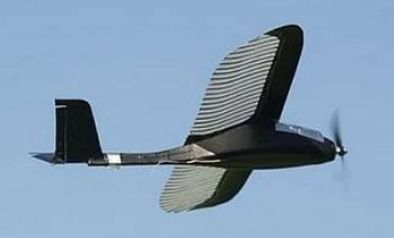AFRL BATCAM
The BATCAM (Battlefield Air Targeting Camera Autonomous Micro-Air Vehicle) was developed by the Munitions Directorate of the Air Force Research Laboratory (AFRL), and first flew in 2003. It was designed as a very light battlefield surveillance UAV for the USAF's BAO (Battlefield Air Operations) kit. The UAV weighs less than 400 grams, and vehicles of this class are planned to replace current systems, which have similar capabilities but weigh several kilograms.
 |
| Photo: USAF |
| BATCAM |
The BATCAM hand-launched air vehicle is powered by a battery-driven electric motor. It uses a GPS/INS navigation system and is equipped with two TV cameras. A forward/downward-looking one for operator orientation, and a side-looking one for oblique surveillance. The operator uses a ruggedized notebook computer to control the vehicle and watch the camera images. A single UAV should be able to complete hundreds of missions, but the air vehicle is cheap enough to be regarded as expendable, if the combat situation doesn't allow safe retrieval.
23 BATCAM systems with two UAVs each have been produced so far. They were built and tested in a "rapid prototyping" style, and in direct cooperation with the troops. Testing continues to improve the UAV's autopilot, its sensors, and the recommended tactics to employ it.
Specifications
Note: Data given by several sources show slight variations. Figures given below may therefore be inaccurate!
Data for BATCAM:
| Length | 61 cm (24 in) |
| Wingspan | 53 cm (21 in) |
| Weight | 0.38 kg (0.84 lb) |
| Speed | ? |
| Ceiling | 300 m (1000 ft) |
| Range | 3 km (1.6 nm) |
| Endurance | 18 min |
| Propulsion | Electric motor |
Main Sources
[1] "Unmanned Aircraft Systems Roadmap, 2005-2030", Office of the Secretary of Defense, August 2005
[2] Frank Colucci: "BAO Kit",
Special Operations Technology Online, August 2005
Back to Directory of U.S. Military Rockets and Missiles, Appendix 4
Last Updated: 1 September 2005